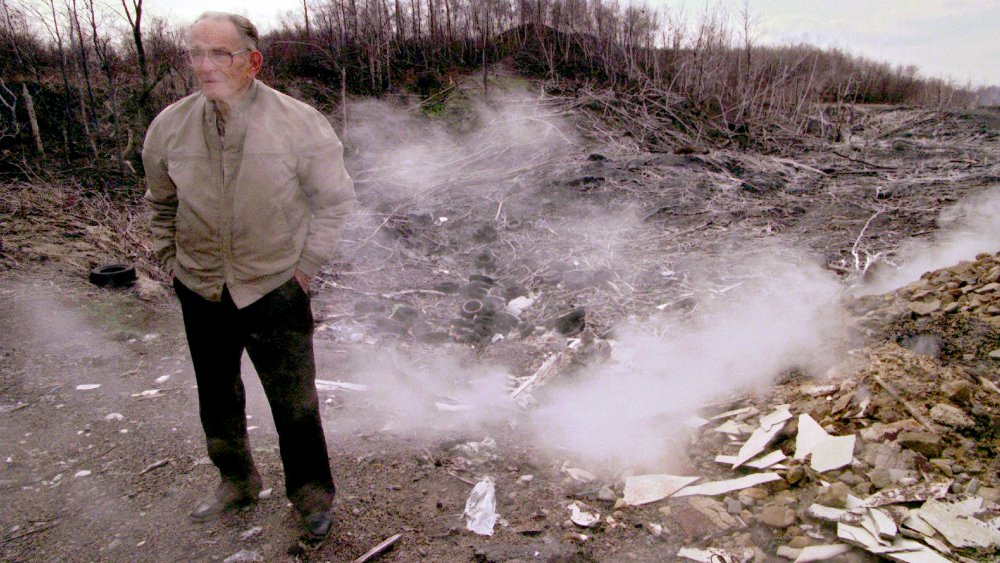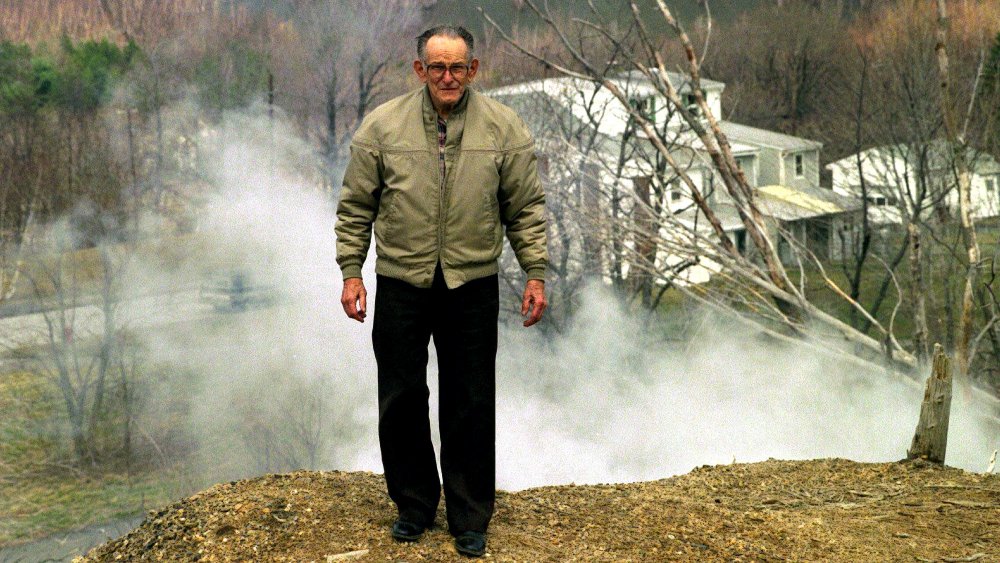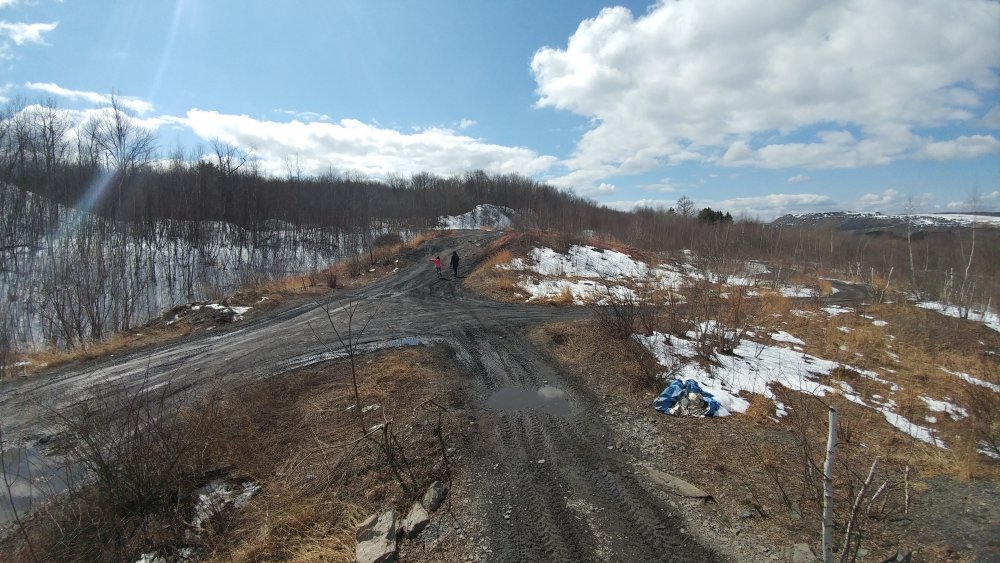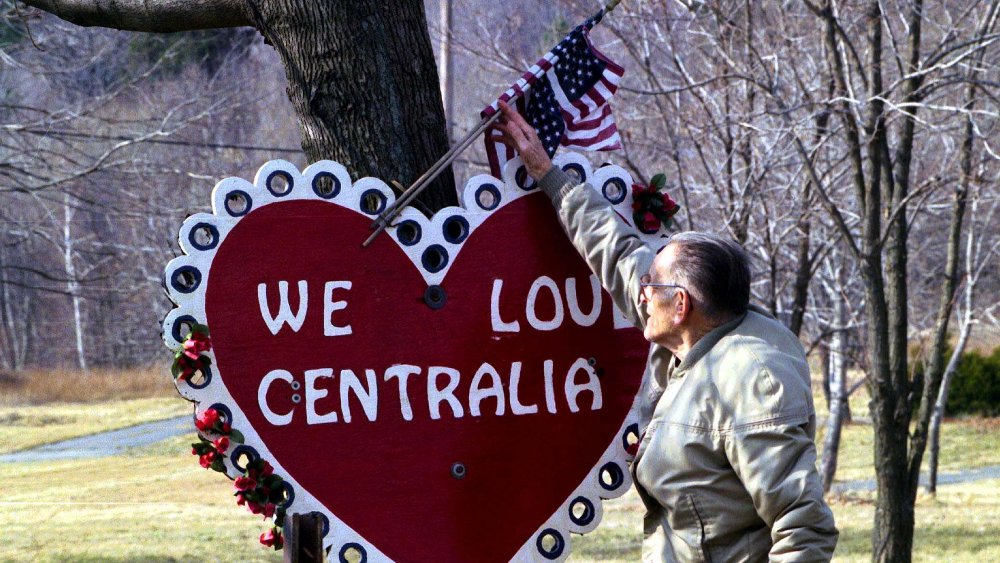The Pennsylvania Town That's Literally Burning From The Inside Out
In early planning for the 2006 film adaptation of Silent Hill, the production team needed an image evocative enough for the metaphorical nature of the town. One early inspiration, the director Chrisophe Gans remembered in an interview with Ecranlarge, was that "Roger Avary sent me a link on a mining town in America ... a cursed city under which the coal fires will burn forever." The town was, and is, Centralia, Pennsylvania and it has been burning ever since 1962. The smoke rising around the photographed figure above is neither a special effect, nor a seasonal occurrence, but an established part of life in Centralia. Some estimate the fire could continue for another 250 years.
Centralia, as OffRoaders explains, was previously known for its large coal reserves. In the town's height, it reached a population of over 2,000 residents. When the census counted Centralia's residents in 2010, though, it recorded ten inhabitants in the ghost town's borough. What happened?
In short, if this were a horror film, Centralia was just the kind of quiet place to accidentally open a mouth to Hell.
Start the fire
No one really remembers exactly what happened on the Memorial Day Weekend of 1962. However, the theory endorsed by David Dekok in Fire Underground: The Ongoing Tragedy of the Centralia Mine Fire is that it was the cleaning of the landfill behind the cemetery that set off the conflagration: "This might seem like irrelevant, small-town history except for one thing: Centralia Council's method for cleaning up a dump was to set it on fire." This, it should be noted, was illegal under Pennsylvania law, so official documents could only note that firefighters had addressed an issue in the landfill. Another theory was that these flames were actually remnants of an old fire in 1932 that had reached the landfill area, thereby removing blame from anyone involved in the landfill fire. Some say it was merely an accident.
Whatever the truth, on Tuesday May 29, the day after Memorial Day, someone noticed smoke rising from the landfill. The town quickly put it out.
A few days later, however, the firemen found a disturbing problem: a hole near the landfill. It hadn't been filled with incombustible materials. Worse, it led to all the mining passages that trailed under the town. As Centralia tried to navigate the government's services to receive help, the fire spread underground, feasting on a large supply of un-mined coal.
"This is fine."
This did not prompt the panic you might expect. In fact, as Emily Harnett wrote in the Baffler, the people of Centralia initially adapted to their new environment: "Sure, sometimes tomatoes would grow in midwinter. Sometimes snow would melt off the smoldering ground before you could shovel it. In places, the earth glowed blue from methane, like the hills themselves were suffocating." With similar attitudes, people simply lived ...
... that is, until 1979, when, as Slate reports, John Coddington, mayor and gas station owner, noticed the temperature of his underground fuel tanks had risen to 172 degrees Fahrenheit. Still, the sense of no harm, no foul, pervaded — until 1981, when a twelve-year-old found the earth crumbling under his feet, threatening to cause his fall into a 150 foot methane-filled pit. Fortunately, he grabbed some tree roots, and survived.
It was also around this time that both the state and federal governments simply gave up on extinguishing the fire. "[By 1980] Pennsylvania didn't have enough money in the bank to do the job," Steve Jones, a geologist with the state's Office of Surface Mining, told Smithsonian Magazine. "If you aren't going to put it out, what can you do? Move the people." So, the government sponsored the move of almost every single person in the entire town. As mentioned earlier, a few people held out, but Centralia's existence now consists less of being an inhabited location, than an out of the way landmark for alternative tourists.
Centralia Today
Today's Centralia community seems primarily focused on various cleaning and rebirthing activities. On the website, CentraliaPA.org, sparse news events announce these clean ups, as well as the emigration of long time residents, whose houses upon their departure revert to the state's ownership, and recently, the postponement of an apple tree planting event due to COVID-19. These are directed by EPCAMR, the Eastern Pennsylvania Coalition for Abandoned Mine Reclamation.
Sadly, Centralia's other notable claim to fame, the Graffiti Highway, will soon disappear. This stretch of road, as CentraliaPA.org explains, was an abandoned section of Route 61 that had to be bypassed due to the threat the Centralia fire posed to the road's integrity. In 2007, however, people began using the unused road as a canvas, spraying paint all over the place and turning the town's tragedy into something beautiful. In April, however, Penn Live reported that Pagnotti Enterprises, the people who bought the land a few years ago, were setting about to cover the highway in dirt. While some locals mourned, burying the tract also won a large amount of approval, even from Bobby Hughes, an officer of the Eastern Pennsylvania Coalition for Abandoned Mine Reclamation who has spent years picking up the trash left by visitors: "People seemed to feel a sense of entitlement to that area, but there are better ways to commemorate Centralia's history." Still, even with the trees planted and paintings sprayed, then covered, the fire has continued raging ... and will continue to rage, for decades.



